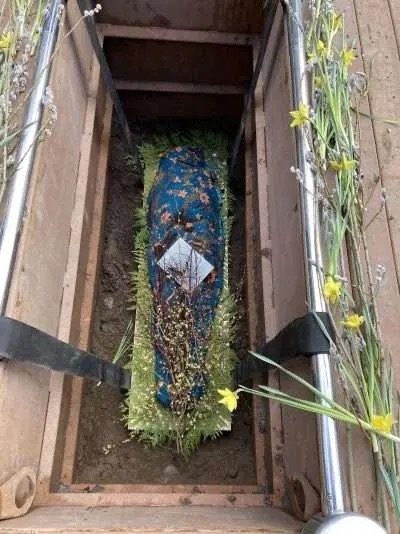The Five Principles of Green Burial
Photo Credit: Heritage Acres Memorial Sanctuary, Cincinnati
Our friends at the Green Burial Society of Canada have identified five principles of green burial. The Gabriola Island Memorial Society is committed to these in establishing a green burial site on Gabriola.
1. No Embalming
Bodies are prepared for green burial without the use of embalming.
Decomposition is nature’s way of recycling a body, without need for intervention by us.
A body that is not embalmed can still be prepared in a dignified way for burial and viewing.
This is made possible with refrigeration and the use of environmentally sensitive soaps, lotions and disinfectants.
2. Direct Earth Burial
The un-embalmed body is wrapped in a shroud made of natural, biodegradable fibers and then buried directly in the grave.
Alternatively, the shrouded remains can be placed into a casket or alternative form of container, where the casket or similar container is also made of sustainable and fully biodegradable materials.
In an ideal circumstance the shrouds and/or casket will be locally sourced, as close as possible to the deceased’s place of death and green burial.
For green burial no outside grave liner or protective vault is used. The body in a shroud or casket is buried directly in the ground.
3. Ecological Restoration & Conservation
Once a green burial has taken place, the surface of the grave is allowed to settle before being restored with locally indigenous species of grasses, flowering groundcovers, shrubs, and trees. Preferably grave restoration is achieved by using a plant palette and plan that has been designed to integrate the area seamlessly into the surrounding landscape and ecosystem.
Key components of green burial are protecting and preserving burial grounds. Covenants, protective easements, and other enforceable guarantees made by the green burial cemetery operator will ensure that the site will never be repurposed and that the ecosystem that evolves there will be protected.
4. Simple Memorialization
For green burial, memorialization should be simple and visually appropriate to the site. Communal memorialization: simple, basic inscriptions on naturally sourced materials is preferred. Alternatively, small, hand crafted, individual monuments may also be used, but these should be made of natural, preferably locally sourced materials.
Ultimately it is the green burial site as whole that becomes a living memorial to the persons interred there.
5. Optimized Land Use
A well planned green burial cemetery (or cemetery section) will optimize the land it occupies.
Design elements will include minimal infrastructure such as temporary roads that can be removed and converted into interment lots, operationally pragmatic grave dimensions, and section lot plans that maximize interment capacity.
The re-use of graves is a highly sustainable practice that optimizes land use in a green burial (or any) cemetery. Common in many places, grave re-use is currently available only at a few cemeteries in Canada.
Where full body interment is not practical or possible, space within a green burial area may be designated for the interment of cremated remains.
For more information on the Green Burial Society of Canada please visit their website: greenburialcanada.ca








